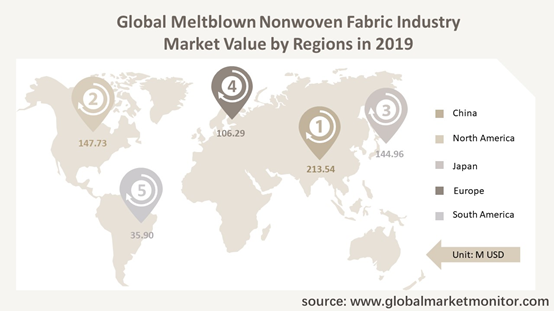Melt-jet nonwoven fabric is a non-woven fabric made by melt-jet method, which USES high-speed hot gas flow to make the polymer melt quickly and at high magnification to stretch and solidify. It is a kind of fabric that does not need spinning and weaving, it is only formed by directional or random arrangement of short textile fibers or filaments to form a network structure, and then reinforced by mechanical, thermal adhesive or chemical methods. Nonwovens break through the traditional textile principle, and has the characteristics of short process, fast production speed, high output, low cost, wide use, and many sources of raw materials. Melt-blown nonwoven fabric is a self-consolidation jumble of ultrafine fibers. Its biggest characteristic is that it is composed of ultrafine fibers with large specific surface area and strong adsorption capacity to particles.
Meltblown Nonwoven Fabric can be classified by type into polypropylene, polyester and polyethylene. Polypropylene occupies the vast majority of the market share. It is a semi-crystalline thermoplastic with high impact resistance, strong mechanical properties and resistance to various organic solvents and acid and alkali corrosion, making it a good material for the production of masks. The market value of Polypropylene has reached $6483 million in 2020.
Meltblown nonwoven products are generally applied in many fields such as filter materials, medical and health, construction, geotextiles and automobiles. Hygiene and construction accounted for the vast majority of the application fields, 36.05% and 20.99% respectively. Melt-blown nonwovens have many advantages, such as soft hand feeling, good filterability, and good air permeability. They are suitable for medical treatment, clothing lining, electronic materials special wipes, isolation clothing. The main products are baby diapers, adult incontinence products, feminine hygiene products, surgical suits, protective clothing, masks, etc. In 2020, the market value in the hygiene sector has reached $1566.27 million. In addition, meltblown non-woven fabrics are also widely used as materials for house packaging and roofing. They have good waterproof performance, air permeability and strong temperature adaptability. In 2020, its market value has reached $309.01 million.
Global Meltblown Nonwoven Fabric Industry Market Status and Prospect Analysis

China is the largest revenue market, with a market share of 21.28% in 2015 and 27.79% in 2019, an increase of 6.51%. As the second largest economy in the world, China has stable social development, a sound legal system, and free flow of production factors such as capital, goods, talents, and information, providing a good market environment for the development of the industry. Most of the meltblown nonwovens companies are from China. Its market value in 2019 has reached $213.54 million. With the continuous development of economy and technology, the continuous expansion of downstream demand and the increase of product supply companies, it is expected that its market share will further expand in the future.
Due to advanced technology and high consumption capacity, North America has formed a mature industrial chain. In recent years, manufacturing has become a key area supported by the US government. As the epidemic further spreads, governments at all levels may adopt larger-scale control measures against the epidemic. The US manufacturing industry will continue to be under pressure in the short term. However, as the epidemic is gradually brought under control, the development of the industry is expected to continue to advance. It is estimated that by 2025, its market value will rise from $147.73 million in 2019 to $539.45 million.
Get the complete sample, please click: https://www.globalmarketmonitor.com/reports/762793-meltblown-nonwoven-fabric-market-report.html
Under the Influence of COVID-19, the Future Trend of the Global Meltblown Nonwovens Industry
The total revenue of the global meltblown nonwovens market in 2015 was $588.53 million. However, the sudden outbreak of the epidemic has interrupted the raw material supply chain and workers are unable to work, which has seriously affected the normal operations of many manufacturers. However, the arrival of the epidemic has also made many people aware of the importance of masks. Therefore, the demand for masks has soared. Many companies are scrambling to devote themselves to the production of meltblown material. In 2020, its total revenue reached its peak in recent years, increasing to $2414.78 million. It is estimated that by 2025, after the epidemic is gradually brought under control, the value of the meltblown nonwovens market will decline to some extent, returning to $1756.59 million.
However, meltblown nonwovens have many limitations that will affect the expansion of the industry. Only low-viscosity materials can be spun into a melt blown web. The inability to use different polymers also limits the many applications of melt blown webs. In addition, the mechanical properties of melt-blown fibers are low, which increases the cost and manufacturing complexity of melt-blown nonwoven fabrics. The fragility of meltblown fiber webs also brings difficulties to downstream processing. Moreover, meltblown fabrics are difficult to dye, and it is also difficult to combine with other non-woven filter media structures. These factors will inhibit the further development of the meltblown nonwoven fabric market.
Meltblown nonwovens still have a variety of excellent characteristics and short production cycles, so they are widely used in many fields, such as filter materials, medical sanitary materials, and environmental protection materials. In recent years, new raw materials for meltblown nonwovens have emerged one after another. Many materials with high temperature resistance, high elasticity and high performance have also appeared, so the application prospect is very broad. In addition to the continuous innovation of raw materials, meltblown technology is also constantly innovating and optimizing. Therefore, the development potential of the industry is huge, and its market value is expected to rise steadily in the next few years.
Get the complete sample, please click: https://www.globalmarketmonitor.com/reports/762793-meltblown-nonwoven-fabric-market-report.html
We provide more professional and intelligent market reports to complement your business decisions.